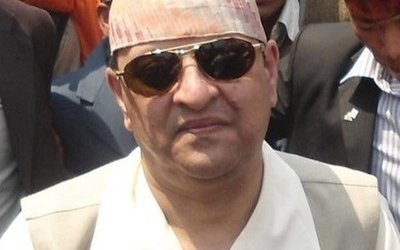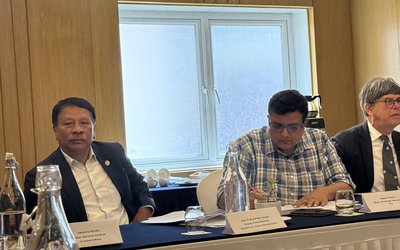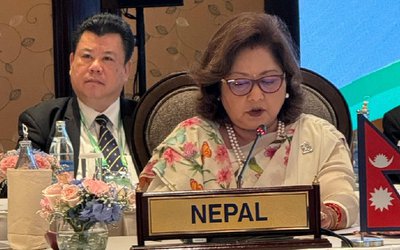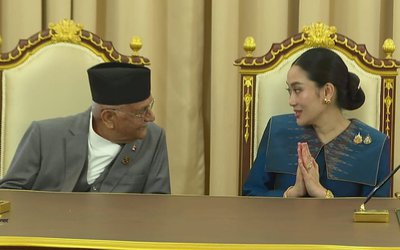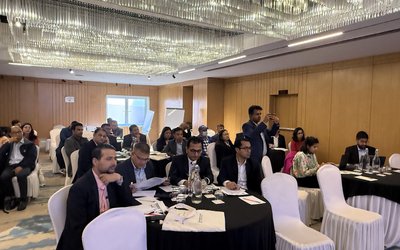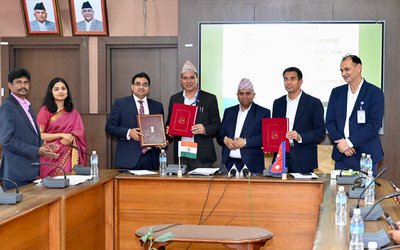
Current State of Electricity
With a hundred and ten years long history full of ups and downs of hydropower development, Nepal's installed capacity at present is 1,275.54 Megawatts (MW). If one is to examine the provisions of the Electricity Act, 1992 and Electricity Regulation, 1993, the private sector, apart from the government-owned Nepal Electricity Authority (NEA) holds a vital position in the development of the electricity sector.
As per the annual report published by the NEA 2019/20, out of the total 7,741 Gigawatt hours (GWh) of electrical energy available in NEA’s system, internally generated electricity (39.02% from NEA and 38.64% from the Independent Power Producers) amounted to about 78% and the remainder 22.23% of electricity was imported from India. Likewise, the peak demand for electricity was 1,408 megawatt.
According to the Department of Electricity Development (DOED), 109 projects in the domestic electricity generation within the country are currently under operation- with the total installed capacity at 1,289 MW. Out of these, 85 projects with 654 MW of installed capacity are operated by the Independent Power Producers whereas the remaining projects were developed under the NEA and its subsidiary companies. Similarly, survey licenses are awarded to a total of 289 projects including hydropower, along with some solar-power and wind-power projects with the potential generation capacity of 17,000 MW. A total of 41 projects with a generation capacity of around 3,000 MW have applied for construction license after duly having completed the surveying. Out of these projects, approval has been provided to 238 projects under the ownership of government-owned companies as well as private sector promoters, to generate around 8,000 MW of electricity.
As per the NEA's annual report of 2019/20, projects around 3000 MW of generation capacity are currently under construction phase upon financial closure, whereas other projects of around 5000 MW of generation capacity are to undergo financial closure soon.
With regards to the transmission line, currently, 10 transmission line projects have applied for construction licenses after having completed the survey works. Likewise, 136 projects are under construction after having received a construction license. Approximately 3500 circuit kilometers of transmission line above 66 kV capacity are currently under operation, and around 3400 circuit kilometers of a transmission line is under construction. Also, substations of around 3800 MVA capacity are currently under operation whereas substations of around 9800 MVA capacity are under construction.
According to NEA's annual report of 2019/20, 86% of Nepal's populations are currently receiving electricity through the grid, whereas the Government of Nepal has aimed to provide the reach of electricity to the entire population of Nepal in the next three years. NEA's total number of consumers are currently around forty-two lakhs, seventeen thousand seven hundred and ten, divided in a category such as domestic, community, commercial, non-commercial, drinking water, agriculture, transportation, industrial, etc. Out of its total number of consumers, the domestic category consumers form around 93.26% of the total number of consumers and contribute around 39.84% of NEA's total revenue. Similarly, industrial consumers form only 1.3% of the total number of consumers but generate 37.51% of the revenue. It is seen that the remainder of NEA's income is through other consumer categories and through other services. Thus, it can be observed that NEA needs to pay more attention to the consumption of electricity by the domestic sector.
Electricity Regulation
If the colossal potential carried by Nepal's electricity sector is to be achieved, utilities under the Government of Nepal along with the private sectors need to be encouraged and provided equal opportunities. Hence, the regulation of this sector is extremely necessary for this very reason. A regulatory body such as the Electricity Regulatory Commission plays a vital role, with respect to the generation, transmission and distribution of electricity, for technical management, determining of consumer tariff and regulation of power purchase, to maintain competition and safeguard consumer interest, to maintain organizational good governance by extending the organizational capacity of licensees, to provide necessary suggestions and recommendations to the Government of Nepal with respect to the electricity sector, and for resolution of the dispute between licensees, stakeholders and common people.
Nepal Electricity Authority Act, 1984 had given the NEA, a sole authority regarding generation, transmission, distribution of electricity along with determining of consumer tariff. However, the Electricity Act, 1992 and Electricity Regulation, 1993 introduced the provisions to encourage private sectors in the generation of electricity, along with the formation of Electricity Tariff Fixation Commission for determining consumer tariffs. Nevertheless, the practice at present is that NEA is a sole player regarding the purchase of power, distribution, system operations along with construction and operation of transmission lines, which has barricaded the concept of multi-buyer and multi-seller. For this very reason, people are unable to choose the power utility of their choice. Even for the electricity generation licensees, there is a risk that one party could be in a dominant position in the power purchase rate and conditions set in the agreement, given that there is only one power purchaser.
Apart from technical reasons, investors, big and small, are at risk due to the inability of power producers to maintain good governance. In such a given context, the parliament promulgated the Electricity Regulatory Commission Act, 2017 to address the need to make the generation, transmission, distribution and trade of electricity simple, regular, properly managed and transparent. In accordance with the same Act, the government approved the Electricity Regulatory Commission Regulation, 2018. The Electricity Regulatory Commission has been thereafter continuing its operation after the appointment of its members and chairperson.
The Commission shall implement certain foundational principles in the implementation of its regulatory role. Whilst implementation of the basic principles, (a) consumers shall get qualitative and safe electricity service, (b) electricity distribution licensee shall get a fair return on their equity (c) consumers' rights shall be protected, (d) the technological and non-technological parts of the electricity generation, transmission, distribution and trade shall be developed as per international standard, (e) generation, transmission, and distribution tariff shall be determined transparently and based on the cost and incentive-based mechanism, (f) the electricity sector shall be more competitive, (g) internal control system of the persons and organizations involved in the generation, transmission and distribution of electricity shall be established leading to maintenance of good-governance, (h) the dispute between licensed persons and organizations shall be resolved in accordance with national and international mechanisms.
Different models of regulation may be adopted to obtain results once the aforementioned basic principles are implemented. For example, orders and controlled models where standards are defined by the law and the regulator have prescribed for scrutinized punishment for every action. Such models are deemed relevant in a centralized and controlled system of governance. Likewise, self-regulation- where the private sector makes its own regulation strategy and standard and manages the same. Such a model is relevant in a more open and liberal governance system. The next, regulation based on incentive, where there shall be punishment for those who perform bad and incentivize for those who perform well. For a developing country like Nepal, such regulation based on incentive and encouragement looks appropriate.
Challenges and Aspirations of Electricity Regulation
In Nepal's electricity sector's history of one hundred and ten years, around eight hundred projects are currently in various stages, under the private sector and governmental instruments. On the other hand, the biggest public enterprise of Nepal, the NEA, is the sole purchaser and distributor of electricity in the country. In such a circumstance, the Commission has the challenge to make the electricity market more competitive, to determine the generation, transmission and distribution tariff of electricity in a more transparent manner, to ensure a level playing field to all operators to transmission and distribution facilities, to make a safe and reliable supply of electricity, to monitor whether the consumers are getting standard and quality service and get value for their tariff.
On one hand, these challenges are to be converted into opportunities, whereas on the other hand, stakeholders are desirous that the Commission must intervene at once given the present condition and decreasing the value of the shares. Moreover, the independent power producers are of the desire that the procedure for power purchase shall commence from the Commission at the earliest and uplift the old project.
Likewise, the electricity distributor also, at times, expresses the desire that the Commission approves the documents submitted by it, without much examination. Therefore, the consumers, hydropower investors, private sectors and the utility, all have high expectations from the Commission.
Opportunity and Challenges of Regulation
Since regulation is a novel concept in Nepal, the regulator must pay heed to mostly two subjects in the initial period of its formation. Firstly, the regulator should be mindful of its decisions since the decision of the regulator could cause regulatory shock to stakeholders. Secondly, the regulator should also be mindful of the fact that since the regulator is a new body, the influence from stronger agencies could consequence in regulatory capture.
Similarly, the regulatory body should move forward in a phased manner in order to save itself from these two extreme circumstances. It is found out that such a model is accepted by most regulatory bodies of South Asian countries in the initial phases of its formation. The operation of the Commission can be divided into the following three stages, from the formation phase until the Commission's maturity:
The first stage shall be of around two years, where the current practices are consolidated, and built on in the form of regulatory instrument, and the Commission's organizational structure, employee and financial regulation are formed. If such is done, the primary stakeholders shall accept the decisions made through the regulatory instruments. Likewise, the decisions shall be implemented conveniently. In this period, all the stakeholders must be made informed about the Commission's jurisdiction, prospective work-plan, etc.
In the second stage, new regulatory instruments are to be implemented upon necessary consultation with the stakeholders. This stage shall be for around two years, during which the Commission shall have itself established as an independent regulatory body.
In the third stage, the Commission shall implement necessary regulatory instruments for the purpose of improving the electricity market and implementing competition. Similarly, the Commission shall attain the capacity to deliver suggestions to the government after having its internal capacity developed fully.
By developing itself through the three stages, the Commission shall use modern technology, sectorial experts, and its structural mechanisms to discuss the current problems in the hydropower sector such as of interest rates, refinancing, debt period, etc. For the long term resolution, the Commission must coordinate with the economic regulatory agencies (such as Nepal Rastra Bank, Securities Board of Nepal, Insurance Board) and Nepal Bankers Association and push for resolution of the problem. In addition to that, the commission will also have to establish and implement standards of good governance for independent power producers.
NEA's financial conditions may be at risk with the extensive expansion in the generation of electricity in the next few years without the certainty in the electricity market. Thus, the construction of the cross-border transmission lines and the power distribution system must be strengthened for this reason. Also, the electricity markets of India and Bangladesh must be integrated with the market of Nepal for the purpose of sale and purchase of electricity, with the help of transmission lines of larger capacity. For the same, the Commission must make a directive pertaining to the cross-border power trade to inspire for the promotion, extension and diversification of the electricity market.
In the end, there is no disparity in the fact that the nation shall reap greater fruits if the challenges along with the opportunities before the Commission are correctly addressed and managed. Thus, the need of the hour is to maintain the recent development in the power sector, to make certain the electricity market, to increase the professionalism among the independent power producers, to draft and implement regulatory instruments, to provide reliable, accessible, affordable and safe electricity service, the coordination and cooperation between all the stakeholders involved in the development of the power sector is a must.
Ram Prasad Dhital Ph.D. is Member | Planning & Monitoring, Regulatory and External Affairs Electricity Regulatory Commission, Nepal


